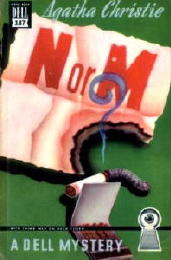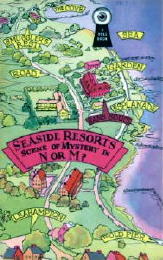Thu 21 Jun 2007
AGATHA CHRISTIE – N or M?
Dell 187, reprint paperback: mapback edition; no date stated, but generally accepted as 1947. Hardcover editions: Collins Crime Club (UK), 1941; Dodd, Mead (US), 1941.
I will not be so foolhardy as to list all of the editions that this book has been published in, nor will I supply more than the front and back cover of this particular mapback edition, especially since the jackets of the respective hardcover editions are so rather plain and unexciting.
But speaking of mapbacks, what I just realized now, strangely enough, is that not once while reading N or M? did I refer to the back cover. Not until getting an image ready for uploading did I even think of it. And so, looking it just now, I find it utterly remarkable that while I all of the geographical details of the small seaside resort town of Leahampton essentially wrong in my mind, the overall picture in my head was exactly right. (And of course who is there to say that the artist who drew the map had the details right?)

This is a Tuppence and Tommy (Beresford) book, and if you were to check the date that the book was published (1941), you might immediately gather that this wartime book had something to do with the war, and indeed it does. (It is my impression that relatively few murder mysteries published during the war ever mentioned the war, but this one does, and directly so. Other handedly, my impression could be totally false. It is a subject worthy of further investigation.)
I have not read the earlier books in the Tuppence and Tommy series in quite some time, so I do not recall in which one of them the twosome were secret agents in World War I, but when this book begins, they are beginning to feel their age, not to mention the pain of their rejection, as sitting on the sidelines is not their idea of how to spend the time they find free on their hands, nor in any way how to make the best use of their abilities.
A small pause here while I investigate and come back with a short list of the books in which the pair of intrepid adventurers appeared:
The Secret Adversary, 1922. [This must be the World War I adventure .]
Partners in Crime, 1929. [A story collection disguised as a novel.]
N or M?, 1941.
By the Pricking of My Thumbs, 1968.
Postern of Fate, 1973.
That’s quite a range of dates, and the gap between the 3rd and 4th is a huge one, 27 years, but I don’t imagine that it is anywhere near a record — the longest break between appearance of series characters. (A question like this is something else I wish I had more time to look into.)
But back to the story. Luckily enough Tommy is offered a job by the British equivalent of Homeland Security, so hush-hush, he is advised, that he should not even tell Tuppence. Who, of course, has other ideas, and thus indeed there is a story.
It seems that a pair of spies for the Germans, N (a man) and M (a woman) are located in the aforementioned seaside resort town of Leahampton, and in particular they may even be living there in a private hotel called Sans Souci. An amateur is precisely what is required, Tommy is told, as a professional would be spotted right away.

During wartime towns like Leahampton would be populated by (as related on page 14): “old ladies, old colonels, unimpeachable spinsters, dubious customers, fishy customers, a foreigner or two. In fact, a mixed bag.” And the two spies, Tommy again is advised, are among them.
Now if there are people Agatha Christie could write about more capably than “old ladies, old colonels, unimpeachable spinsters, dubious customers, fishy customers, a foreigner or two,” I don’t know who they would be, nor do I know of any other mystery writer could outdo her in this regard, either.
What with the number of people staying on at Sans Souci to describe and make distinguishable, it might have been a Herculean task to succeed in doing so, but what Agatha Christie had was a knack of instant characterization for the inhabitants of her stories, and so it is here. And there is more. Christie is often put down for mysteries that focus more on the plots than they do on the writing of them, but such critics are generally wrong, as this book amply demonstrates. It is so smoothly written that 50 pages flash by in what seems to be an instant — gently humorous at times, sometimes (later on) deadly serious, and with a sense that something suspicious is always going on.
There are a good many suspects at hand, in other words, in an oddly arranged version of the closed manor house type of mystery, but with little of substance to back up this statement, I do not believe that spies and espionage were Ms. Christie’s strongest points. Or in other words, where the book fails, if indeed it does, is in the plotting, which seems forced and unconvincing, concluding with some derring-do and remarkable rescuing that seems entirely fortuitous.
And that the bring-down-the-curtain revelation at the end was one that I was suspicious about myself several pages earlier — “What’s going on here?” I wondered to myself (you’ll have to take my word for it) — which only goes to reinforce the statement I made in the preceding paragraph. Entirely enjoyable then, is my conclusion, but weakest precisely (and curiously) where you’d expect an Agatha Christie novel not to be.
June 21st, 2007 at 1:44 pm
Steve, this was the first crime book I read, when I was about ten, and I absolutely loved it. Curiously, I don’t remember Tommy and Tuppence being older and jaded, but maybe that’s because as a 10 year old, everyone seems older and jaded. Perhaps reading it as a child is the key to unfettered enjoyment.
As an aside, I saw a Marple or Poirot adaptation last year on TV in which Tuppence was one of the characters – played by Greta Scaachi, something of a secret drinker and definitely jaded, which suggests that in some strange way there was more mileage in these two characters than there ever was in the more famous Christie creations.
June 21st, 2007 at 1:58 pm
Hi Kevin,
I didn’t mean to suggest as strongly as you took me to say that Tommy & Tuppence were jaded. In N or M?, they are starting to feel some aches and pains, but rather than jaded, I saw them as frustrated and antsy that they weren’t being called upon to help with the new war effort. Which is to say, World War II.
On the other hand, I don’t know how they felt about the world in their later adventures, and it was certainly a few years later by then. I read one of the last two, don’t remember which one, but I do remember not liking it at all.
I have heard rumors that the recent Christie adaptations had converted Tuppence into a secret tippler, and that I definitely don’t remember in the books. If it’s so, I plan to either stay far away, or (and I can do this) convince myself that it’s another character altogether, and not Agatha Christie’s.
June 21st, 2007 at 2:17 pm
Steve, I’ve just done some research and the adaptation I’m talking about is “By the Pricking of My Thumbs”, rechristened for TV in 2006 as “Marple: By the Pricking of My Thumbs”, and yes, it becomes a vehicle for Miss Marple with Tommy (Anthony Andrews) and Tuppence (Scaachi) as grateful hangers on. I’m assuming this is because the Poirot and Marple brands have been running out of source material. Unfortunate.
October 6th, 2010 at 11:53 am
please iwant to know what is the meaning of n or m
October 6th, 2010 at 4:55 pm
According to Wikipedia: The title is taken from a catechism in the Book of Common Prayer which asks, “What is your Christian name? Answer N. or M.”
In terms of the plot, also from Wikipedia, but amplifying my own description:
“The duo begin a search for a German agent who may have infiltrated British command. Another British agent that was following these Germans left a cryptic message on his deathbed: “N or M. Song Susie”. Grant knew that “Song Susie” stood for Sans Souci, a hotel in Leahampton, and N and M were two German spies, one male and one female. Tommy is to go to Sans Souci to investigate whether N, M or both are at the hotel and to figure out their identities.”